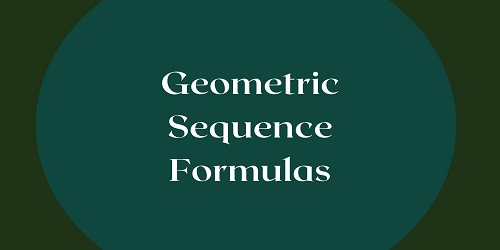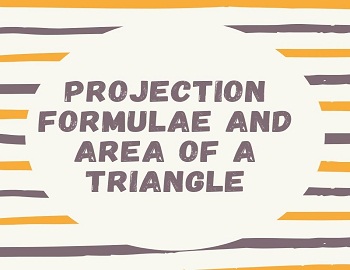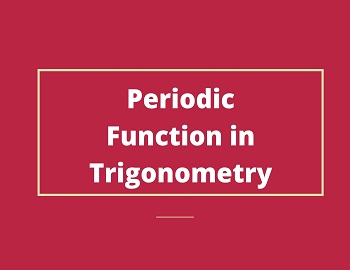Geometric Sequence Formulas:
A sequence of non-zero numbers is said to be a geometric sequence if the ratio of any term to its succeeding term remains constant. This constant is called the common ratio of the geometric sequence denoted by ‘r’ i.e.
| r = an / an-1 |
Geometric Sequence is also called Geometric Progression.
General Form of Geometric Sequence:
If a be the first term and r be the common ratio of the geometric sequence, then its general form is a, ar, ar2. ar3, ……..
nth– term of Geometric Sequence:
If a be the first term and r be the common ratio of the geometric sequence, then its nth term is given by-
| an = arn-1 |
Selection of terms in Geometric Sequence:
| Number of Terms | Terms to be Selected | Common Ratio |
|---|---|---|
| 3 | a/r, a, ar | r |
| 4 | a/r3, a/r, ar, ar3 | r2 |
| 5 | a/r2, a/r, a, ar, ar2 | r |
Sum to n-Terms of a Geometric Sequence:
Let a be the first term and r, be the common ratio of a Geometric Sequence. If Sn denotes the sum of the first n terms, then
| Sn = a + ar + ar2 + … + arn-1 ∴ r . Sn = ar + ar2 + ar3 + … + arn-1 + arn Subtracting, Sn (1 – r) = a – arn ⇒ Sn (1 – r) = a (1 – rn) ⇒ Sn = a (1 – rn) / (1 – r) ………..(i) This formula is suitable for finding out the sum of n terms in the Geometric Sequence when |r| < 1. But if |r| > 1, then we write, ⇒ Sn = a (rn – 1) / (r – 1) ………..(ii) If r = 1, then the above formulae fail to find out the sum. But in this case, Sn = a + a + a + … + to n terms = na |
Sum to Infinite Terms of a Geometric Sequence:
| S∞ = a/(1 – r) [r < 1] |
| Example- Find the eighth term and the general term of the geometric sequence 9, 18, 36, … Solution- The given geometric sequence is, 9, 18, 36, … Here, a = 9, r = 18/9 = 2 Now, an = arn-1 ⇒ an = 9 (2)n-1 and a8 = 9 (2)7 ⇒ a8 = 9 (128) ⇒ a8 = 1152 |
| Example- The third term of a G.P. is 12. Find the product of its first five terms. Solution- Let ‘a’ and ‘r’ be the first term and common ratio of G.P. such that- a3 = 12 ⇒ ar2 = 12 ……….(i) Now, the product of the first five terms of G.P. = (a) (ar) (ar2) (ar3) ar4) = a5r1+2+3+4+5 = a5r10 = (ar2)5 = 125 |
| Example- If l, m, and n be the pth, qth and rth terms of a G.P. respectively, show that lq-r mr-p np-q = 1. Solution- Let ‘a’ and ‘r1‘ be the first term and common ratio of a G.P. respectively. Now, ap = l ⇒ ar1p-1 = l Also aq = m ⇒ ar1q-1 = m and ar = n ⇒ ar1r-1 = n Now, lq-r mr-p np-q = [ar1p-1]q-r [ar1q-1]r-p [ar1r-1]p-q = aq-r . r1(p-1) (q-r) . ar-p . r1(q-1) (r-p) . ap-q . r1(r-1) (p-q) = aq-r+r-p+p-q . r1pq-pr-q+r+qr-qp-r+p+rp-rq-p+q = a0 . r10 = 1 |
| Example- The third, seventh, and eleventh terms of a geometric sequence are x, y and z respectively. Show that y2 = xz. Solution- Let ‘a’ and ‘r’ be the first term and common ratio of a geometric mean respectively. Now, a3 = x ⇒ ar2 = x ……….(i) Also a7 = y ⇒ ar6 = y ……….(ii) and a11 = z ⇒ ar10 = z ……….(ii) Now, xz = (ar2) (ar10) ⇒ xz = a2r12 ⇒ xz = (ar6)2 ⇒ xz = y2 |
| Example- If ax = by= cz and x, y, z are in geometric sequence, prove that logba = logcb. Solution- ax = by = cz and x, y, z are in geometric sequence. y2 = xz ⇒ x = y2/z ……….(i) Now, ax= by = cz Apply log log ax = log by = log cz ⇒ x log a = y log b = z log c = k ⇒ log a = k/x, log b = k/y and log c = k/z Now, logba = log a/log b = (k/x)/(k/y) = y/x = y/(y2/z) [using (i)] = z/y ……….(A) Now, logcb = log b/log c = (k/y)/(k/z) = z/y ……….(B) From (A) and (B):- logba = logcb |
| Example- If a, b, c are in a geometric sequence, prove that 1/loga m, 1/logb m, and 1/logc m are in an arithmetic sequence. Solution- a, b, c are in a geometric sequence ⇒ b2 = ac Apply log ⇒ log b2 = log ac ⇒ 2logm b = logm a + logm c ⇒ logm a, logm b, logm c are in an arithmetic sequence. ⇒ 1/loga m, 1/logb m, 1/logc m are in an arithmetic sequence. |
| Example- If l, m, n are in A.P., show that the lth, mth and nth terms of any G.P. are also in G.P. Solution- l, m, n are in A.P. ⇒ 2m = l + n ⇒ m + m = l + n ⇒ m – l = n – m ……….(i) Let ‘a’ and ‘r’ be the first term and common ratio of a geometric sequence. Now, al = arl-1 am = arm-1 and an = arn-1 Now, am/al = arm-1/arl-1 ⇒ am/al = rm-l ……….(ii) and an/am = arn-1/arm-1 ⇒ an/am = rn-m ……….(ii) From (i), (ii) and (iii):- am/al = an/am ⇒ (am)2 = (al) (an) ⇒ al, am, an are in a geometric sequence. |
| Example- Find the fourth term from the end of the G.P. 6, 12, 24, …….. 24576. Solution- The given G.P. is 6, 12, 24, …….. 24576 or 24576, 12288, …….., 24, 12, 6 Here a = 24576, r = 1/2 Now, a4 = ar3 = 24576 (1/2)3 = 24576/8 = 3072 |
| Example- The sum of three numbers in G.P. is 65 and their product is 3375. Find the numbers. Solution- Let three numbers in G.P. be a/r, a, ar Now, (a/r) (a) (ar) = 3375 ⇒ a3 = 3375 ⇒ a3 = 153 ⇒ a = 15 Also, a/r + a + ar = 65 ⇒ a (1/r + 1 + r) = 65 ⇒ 15 (1 + r + r2)/r = 65 ⇒ 3 + 3r + 3r2 = 13r ⇒ 3r2 – 10r + 3 = 0 ⇒ r = 3, 1/3 ∴ three numbers in G.P. are 5, 15, 45, or 45, 15, 5. |
| Example- If x, 2x + 2, 3x + 3 are the first three terms of a G.P., find its fourth term. Solution- x, 2x + 2, 3x + 3 are first three terms of G.P. ⇒ (2x + 2)2 = x (3x + 3) ⇒ 4(x + 1)2 = 3x (x + 1) ⇒ 4(x + 1) = 3x ⇒ 4x + 4 = 3x ⇒ x = -4 ∴ three terms in G.P. are -4, 2(-4) + 2, 3(-4) + 3 = -4, -6, -9 Here r = -6/-4 = 3/2 ∴ an = ar3 ⇒ an = (-4) (3/2)3 ⇒ an = -4 x 27/8 ⇒ an = -27/2 |
| Example- How many terms of the geometric sequence 6, 3, 3/2 ……… are needed to give the sum 3069/256? Solution- The given geometric sequence is, 6, 3, 3/2 ……… Here a = 6, r = 3/6 = 1/2 Let Sn = 3069/256 ⇒ a(rn – 1)/(r – 1) = 3069/256 ⇒ 6[(1/2)n – 1]/[(1/2) – 1] = 3069/256 ⇒ 6[(1/2)n – 1]/(-1/2) = 3069/256 ⇒ -12 [(1/2)n – 1] = 3069/256 ⇒ 12 (1 – 1/2n) = 3069/256 ⇒ 1 – 1/2n = 3069/256 x 12 ⇒ 1 – 1/2n = 1023/1024 ⇒ 1 – 1023/1024 = 1/2n ⇒ 1/1024 = 1/2n ⇒ 1/210 = 1/2n ⇒ n = 10 |
| Example- Find the sum to n terms 6 + 66 + 666 + ……… Solution- Let Sn = 6 + 66 + 666 + ……… to n terms ⇒ Sn = 6 [1 + 11 + 111 + ……… to n terms] ⇒ Sn = 6/9 [9 + 99 + 999 + ……… to n terms] ⇒ Sn = 6/9 [(10 – 1] + (100 – 1) + (1000 – 1) + ……… to n terms] ⇒ Sn = 6/9 [(10 + 100 + 1000 + ……… to n terms) – n] ⇒ Sn = 6/9 [(sum of n terms of G.P. with a = 10, r = 10) – n] ⇒ Sn = 6/9 [{10 (10n – 1) / (10 – 1)} – n] ⇒ Sn = 6/9 [10 (10n – 1)/9 – n] ⇒ Sn = (6/9) [10 (10n – 1) – 9n]/9 ⇒ Sn = (6/81) (10n+1 – 10 – 9n) ⇒ Sn = (2/27) (10n+1 – 9n – 10) |
| Example- If the fourth and the seventh terms of a series in G.P. be 24 and 192 respectively, find the sum of its first twelve terms. Solution- Let ‘a’ and ‘r’ be the first term and common ratio of a G.P. respectively such that a4 = 24 ⇒ ar3 = 24 ……….(i) and a7 = 192 ⇒ ar6 = 192 ……….(ii) Dividing (i) by (ii):- ar6/ar3 = 192/24 ⇒ r3 = 8 ⇒ r = 2 Substitute r = 2 in equation (i):- a(2)3 = 24 ⇒ 8a = 24 ⇒ a = 3 ∴ Sn = a (r12 – 1) / (r – 1) ⇒ Sn = 3(212 – 1)/(2 – 1) ⇒ Sn = 3(4096 – 1)/1 ⇒ Sn = 3(4095) ⇒ Sn = 12285 |








Comments (No)